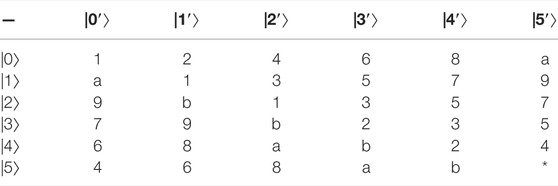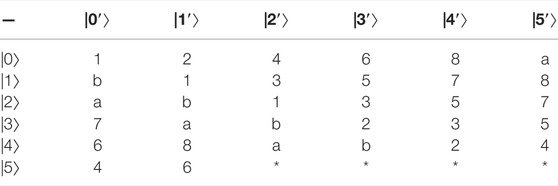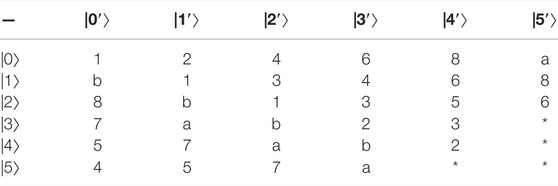- 1Department of Big Data, School of Science, Zhejiang University of Science and Technology, Hangzhou, China
- 2Department of Mathematics, College of Sciences, Yanbian University, Yanji, China
We systematically study the constructions of unextendible entangled bases with a fixed Schmidt number k (UEBk) in a bipartite system
1 Introduction
Entanglement is an essential resource of quantum information processing, and it presents the nature of quantum mechanics [1, 2]. It is also related to some fundamental problems in quantum mechanics such as reality and non-locality [3, 4]. Quantum entanglement has significant applications in many fields such as quantum teleportation [5], quantum dense coding [6], quantum tomography [7], and the mean kings problem [8].
In order to characterize quantum entanglement, the analysis of various bases in the state space has attracted extensive attention in recent years. The notion of unextendible product basis (UPB) in multipartite quantum systems has been deeply studied. The member of a UPB is not perfectly distinguishable by local positive-operator-valued measurements and classical communication, which shows the non-locality without entanglement [9]. As the generalization of UPB, the notion of unextendible maximally entangled basis (UMEB) has been proposed [10]. Since then, many results of UMEBs in arbitrary bipartite spaces are established: no UMEB in
In [19], Guo first proposed the unextendible entangled basis with a fixed Schmidt number k (UEBk) in
Li et al [22] first constructed the SEBks in
In this paper, we mainly focus on the construction of UEBks in bipartite systems. Motivatied by the method of [22, 23], using generalized weighing matrices, we provide flexible and diverse constructions of different members of UEBks. We first introduce some related notions and terminologies; then, we propose three different ways to construct (dd’ − v)-member UEBks in
2 Preliminaries
In order to better comprehend the notion of UEBk in
The Schmidt number of a bipartite pure state
A set of states
(i) Sr (|ϕi⟩) = k and |ϕi⟩, i = 1, 2, … , m are all entangled states;
(ii) ⟨ϕi|ϕj⟩ = δij;
(iii) if ⟨ϕi|ψ⟩ = 0 for all i = 1, 2, … , m, then Sr (|ϕi⟩) ≠ k.
Actually, there is a similar concept in matrix spaces [20]. Let {|k⟩} and {|ℓ′⟩} be the standard computational bases of
A set of d × d′ complex matrices {Ai: i = 1, 2, … , n, n ≤ dd′} is called an unextendible rank-k Hilbert–Schmidt basis of Md×d′ [24] if and only if
(i) rank (Ai) = k for any i;
(iii) if
It turns out that {Ai: rank (Ai) = k} is an unextendible Hilbert–Schmidt basis of Md×d′ if and only if {ϕi} is a UEBk of
We next introduce the definition and properties of a generalized weighing matrix, which has been effectively used to construct SEBks in
Definition 1:. [22] A generalized weighing matrix is a square a × a matrix A all of whose non-zero entries are nth roots of unity such that AA† = kIa. It follows that
Lemma 1:. [22] Let a, b be two positive integers with a great common divisor being g. For any integers d, d′ ≥ max{a, b}, if g|dd’, then dd’ can be written as dd’ = sa + pb, where
3 Three Kinds of (dd’ − v)-Member UEBks
Let Md×d′ be the Hilbert space of all d × d′ complex matrices, V be a subspace of Md×d′ such that each matrix in V is a d × d′ matrix ignoring v elements, depending on the position occupied by the ignored v elements: 1) all the ignored elements occupy N columns, 2) all the ignored elements occupy N rows, and 3) all the ignored elements occupy rows and columns; we construct three kinds of (dd’ − v)-member UEBks.
3.1 All the Ignored Elements Occupy N Columns
In this section, we first construct the (dd’ − v)-member UEBk in
Theorem 1:. Let k be a positive integer,
when s = 0, p ≥ 1, set
when p = 0, s ≥ 1, set
where
with
where C0 = 0, Cα = 1 denotes the ignored elements.We next prove that all the above {|ϕm.l⟩} constitute a dd’ − v (1 ≤ v ≤ d′N)-member UEBk in
(i) It is clear that Sr (|ϕl⟩) = k for any l, m, t.
(ii) Orthogonality.
According to the construction given by the above expression, the elements of each state lie in different rows and columns, so the proof of the orthogonality is as follows:(iii) Unextendibility.
It is obvious that there are no UEBk in V⊥ since N < k.In order to understand the above structure more intuitively, we give the following examples to illustrate it.
Example 1:. Constructing 26-member UEB3 in
According to the proof of Theorem 1, we have the following pure states:
where α = 1, ω, ω2 and
Example 2:. Constructing 29,28,25,24-member UEB3s in
the specific UEB3s of V1, V2, V3, V4 are shown in Table 2‐5 respectively.
3.2 All the Ignored Elements Occupy N Rows
In this section, we first construct the (dd’ − v)-member UEBk in
Theorem 2:. Let k be a positive integer,
if s = 0, p ≥ 1, let
if p = 0, s ≥ 1, let
where
with
where C0 = 0, Cα = 1 denotes the ignored elements. It is worthy of note that β in formula (13) is a regulating term, β = 0 in the common cases, β = 1 if |e⟩|c ⊕(d′−N+1)e⟩ coincides with the previous answer of formula (13).Similiar to Theorem 1, we can prove that {|ϕm.l⟩} constitute dd’ − v (1 ≤ v ≤ dN)-member UEBks in
Example 3:. Constructing 29,26,25,23-member UEB3 in
the specific UEB3s of V1, V2, V3, V4 are shown in Table 6‐9 respectively.
3.3 All the Ignored Elements Occupy Both x Rows and y Columns
In this section, we will construct (dd’ − v)-member UEBk in a bipartite system
Theorem 3:. Let k be a positive integer,
if s = 0, p ≥ 1, set
if p = 0, s ≥ 1, set
where
with
where C0 = 0, Cα = 1 denotes the ignored elements.Similar to Theorem 1, we can prove that {|ϕm.l⟩} constitute dd’ − v (1 ≤ v ≤ d′x + dy)-member UEBks in
Example 4:. Constructing 26,25,24,23-member UEB3 in
the specific UEB3s of V1, V2, V3, V4 are shown in Table 10‐13, respectively.Comparing Tables 4, 8, 11, we can find that they are all 25-member UEB3s in
Example 5:. Constructing 26,25,24,23-member UEB3 in
the specific UEB3s of V1, V2, V3, V4 are shown in Table 14‐17, respectively.
Remark 1:. We systematically show three methods (or orders) to construct the UEBks in different cases and present the corresponding mathematical expressions, which is better than that in [23] since it only provide one limited order. For example, we can construct 23-member SUEB3 in

TABLE 18. construction in [23].
Remark 2:. Our results cover wider spaces than that of Ref. [23]. The smallest space we can discuss is
4 Conclusion
We have proposed three ways to construct different members of UEBks in
By using our constructions, one can get at most (dd’ − v) members of UEBk in
Data Availability Statement
The original contributions presented in the study are included in the article/supplementary material; further inquiries can be directed to the corresponding author.
Author Contributions
Y-HT, X-LY, and S-HW write the paper together; others review and check the paper.
Funding
This work was supported by the Natural Science Foundation of China under Number 11761073.
Conflict of Interest
The authors declare that the research was conducted in the absence of any commercial or financial relationships that could be construed as a potential conflict of interest.
Publisher’s Note
All claims expressed in this article are solely those of the authors and do not necessarily represent those of their affiliated organizations or those of the publisher, the editors, and the reviewers. Any product that may be evaluated in this article or claim that may be made by its manufacturer is not guaranteed or endorsed by the publisher.
References
1. Nielsen MA, Chuang IL. Quantum Computation and Quantum Information. Cambridge, U.K.: Cambridge University Press (2004).
2. Einstein A, Podolsky B, Rosen N. Can Quantum-Mechanical Description of Physical Reality Be Considered Complete? Phys Rev (1935) 47:777–80. doi:10.1103/physrev.47.777
3. Nikolopoulos GM, Alber G. Security Bound of Two-Basis Quantum-Key-Distribution Protocols Usingqudits. Phys Rev A (2005) 72:032320. doi:10.1103/physreva.72.032320
4. Mafu M, Dudley A, Goyal S, Giovannini D, McLaren MJ, Konrad T, et al. High-dimensional Orbital-Angular-Momentum-Based Quantum Key Distribution with Mutually Unbiased Bases. Phy Rev A (2013) 88:032305. doi:10.1103/physreva.88.032305
5. Paw lowski M, Zukowski M. Optimal Bounds for Parity-Oblivious Random Access Codes. Phy Rev A (2010) 81:042326.
6. Wootters WK, Fields BD. Optimal State-Determination by Mutually Unbiased Measurements. Ann Phys (1989) 191:363–81. doi:10.1016/0003-4916(89)90322-9
7. Fernnadez-Parez A, Klimov AB, Saavedra C. Quantum Proces Reconstruction Baed on Mutually Unbiased Basis. Phys Rev A (2011) 83:052332.
8. Englert BG, Aharonov Y. The Mean king’s Problem: Prime Degrees of freedom. Phys Lett A (2011) 84:042306.
9. Bennett CH, Divincenzo DP, Mor T, Shor PW, Smolin JA, Terhal BM, et al. Unextendible Product Bases and Bound Entanglement. Phys Rev Lett (1999) 82:5385–8. doi:10.1103/physrevlett.82.5385
10. Bravyi S, Smolin JA. Unextendible Maximally Entangled Bases. Phys Rev A (2011) 84:042306. doi:10.1103/physreva.84.042306
11. Wang Y-L, Li M-S, Fei S-M, Zheng Z-J. Connecting Unextendible Maximally Entangled Base with Partial Hadamard Matrices. Quan Inf Process (2017) 16(3):84. doi:10.1007/s11128-017-1537-7
12. Chen B, Fei SM. Unextendible Maximally Entangled Bases and Mutually Unbiased Bases. Phys Rev A (2013) 88:034301. doi:10.1103/physreva.88.034301
13. Nan H, Tao Y-H, Li L-S, Zhang J. Unextendible Maximally Entangled Bases and Mutually Unbiased Bases in ℂd ⊗ ℂd′. Int J Theor Phys (2015) 54:927–32. doi:10.1007/s10773-014-2288-1
14. Li MS, Wang YL, Fei SM, Zheng ZJ. Unextendible Maximally Entangled Bases in ℂd ⊗ ℂd′. Phys Rev A (2014) 89:062313.
15. Wang YL, Li MS, Fei SM. Unextendible Maximally Entangled Bases in ℂd ⊗ ℂd′. Phys Rev A (2014) 90:034301.
16. Guo Y. Constructing the Unextendible Maximally Entangled Bases from the Maximally Entangled Bases. Phys Rev A (2016) 94:052302. doi:10.1103/physreva.94.052302
17. Zhang G-J, Tao Y-H, Han Y-F, Yong X-L, Fei S-M. Unextendible Maximally Entangled Bases in ℂpd ⊗ ℂqd. Quan Inf Process (2018) 17:318. doi:10.1007/s11128-018-2094-4
18. Shi F, Zhang X, Guo Y. Constructions of Unextendible Entangled Bases. Quan Inf Process (2019) 18:324. doi:10.1007/s11128-019-2435-y
19. Guo Y, Wu S. Unextendible Entangled Bases with Fixed Schmidt Number. Phys Rev A (2014) 90:054303. doi:10.1103/physreva.90.054303
20. Guo Y, Du S, Li X, Wu S. Entangled Bases with Fixed Schmidt Number. J Phys A: Math Theor (2015) 48:245301. doi:10.1088/1751-8113/48/24/245301
21. Guo Y, Jia Y, Li XL. Multipartite Unextendible Entangled Basis. Quan Inf Process (2015) 14:3553–68. doi:10.1007/s11128-015-1058-1
22. Li M-S, Wang Y-L. Construction of Special Entangled Basis Based on Generalized Weighing Matrices. J Phys A: Math Theor (2019) 52:375303. doi:10.1088/1751-8121/ab331b
23. Wang YL. Special Unextendible Entangled Bases with Continuous Integer Cardinality. arXiv:1909.10043v1 (2019).
Keywords: unextendible entangled bases with a fixed schmidt number k, quantum entanglement, Schmidt number, generalized weighing matrix, entangled bases with a fixed Schmidt number
Citation: Tao Y-H, Yong X-L, Bai Y-R, Xu D-N and Wu S-H (2022) Unextendible Entangled Bases With a Fixed Schmidt Number Based on Generalized Weighing Matrices. Front. Phys. 10:896164. doi: 10.3389/fphy.2022.896164
Received: 14 March 2022; Accepted: 19 April 2022;
Published: 08 June 2022.
Edited by:
Ming-Liang Hu, Xi’an University of Posts and Telecommunications, ChinaReviewed by:
Bin Chen, Tianjin Normal University, ChinaYu Guo, Shanxi Datong University, China
Mao-Sheng Li, South China University of Technology, China
Copyright © 2022 Tao, Yong, Bai, Xu and Wu. This is an open-access article distributed under the terms of the Creative Commons Attribution License (CC BY). The use, distribution or reproduction in other forums is permitted, provided the original author(s) and the copyright owner(s) are credited and that the original publication in this journal is cited, in accordance with accepted academic practice. No use, distribution or reproduction is permitted which does not comply with these terms.
*Correspondence: Shu-Hui Wu, d3VzaHVodWkxMkAxMjYuY29t
 Yuan-Hong Tao
Yuan-Hong Tao Xin-Lei Yong2
Xin-Lei Yong2
















